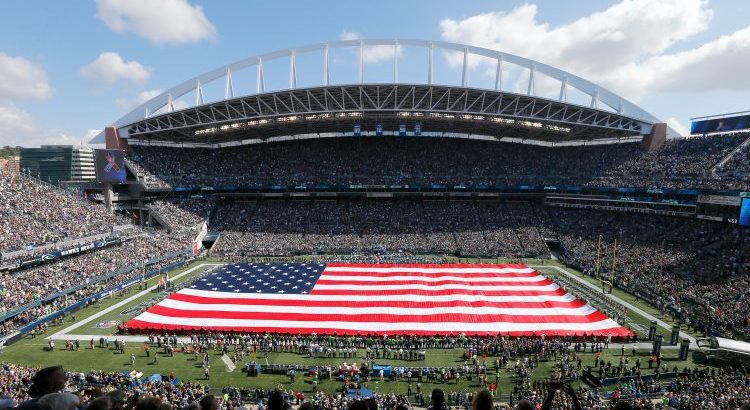The Flag Wars have taken center stage again. In a bizarre twist, politics and sports have become embroiled in a confrontational and, at times, downright laughable war of words and actions. As always, flag waving and the traditional salute and national anthem-singing inspire mixed reactions. According to President Trump— It [standing in a reverential pose as the anthem is played] is about respect for our Country, Flag and National Anthem…” As so often happens, at least since January 20, 2016, when President Trump took up residence in the White House, reaction to his strident nationalism and offensive bravado was instantaneous and, coming as it did from top athletes in the NFL and NBA, generated a storm surge of publicity. From The New York Times: “N.B.A. Players and Coaches Take Aim at Trump,” The New York Post: “Jerry Jones Kneels with Cowboys in pre-anthem statement,” The Hill “Trump calls on NFL to ban kneeling during national anthem,” to internet news sites. Here’s an AlterNet headline NBA Union Head Chris Paul Challenges Trump’s Manhood in Twitter Blast Over Black Athlete Attacks. You can see where this is going.
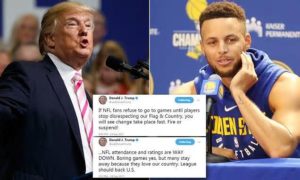 President Trump was determined to have the last word. On September 23, in a speech in Huntsville Alabama, he asked a friendly crowd “Wouldn’t you love to see one of these NFL owners when somebody disrespects our flag [by taking a knee] say ‘Get that son of a bitch off the field right now. He’s fired.” Crowd response — the ubiquitous “USA, USA”. Clearly this was becoming a battle of dueling testosterone. The players’ (and some owners and most coaches) response —a groundswelll in a dizzying array of poses, kneeling, locking arms, or staying off the field as the national anthem played.
President Trump was determined to have the last word. On September 23, in a speech in Huntsville Alabama, he asked a friendly crowd “Wouldn’t you love to see one of these NFL owners when somebody disrespects our flag [by taking a knee] say ‘Get that son of a bitch off the field right now. He’s fired.” Crowd response — the ubiquitous “USA, USA”. Clearly this was becoming a battle of dueling testosterone. The players’ (and some owners and most coaches) response —a groundswelll in a dizzying array of poses, kneeling, locking arms, or staying off the field as the national anthem played.
President Trump waded right into the naming and shaming game: the “bad guys” were a bunch of wealthy, privileged athletes and equally endowed owners and coaches “total disruption of our heritage, of everything we stand for…it’s totally disrespectful.” As for the real Americans, aka his base, they were the ones who “respect our country, flag and national anthem.”
Trump is not the only president to contrast “real” Americans with those who cross him. Another conservative republican president, Richard Nixon, assailed the behavior of what passed for the privileged few in the sixties, not professional athletes but students protesting the Vietnam War. “You can see these bums [profanity not allowed back then] blowing up the campuses. 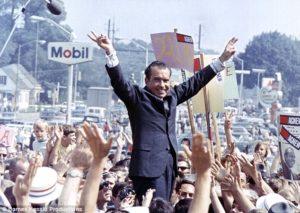 Listen the boys that are on the college campuses today are the luckiest people in the world… Real Americans, on the other hand, [soldiers fighting Vietnam] “Out there we got kids who are just doing their duty and they stand tall…we’ve got to stand back of them.”
Listen the boys that are on the college campuses today are the luckiest people in the world… Real Americans, on the other hand, [soldiers fighting Vietnam] “Out there we got kids who are just doing their duty and they stand tall…we’ve got to stand back of them.”
Little has changed in half a century. Another conservative president using symbols to make the case for exceptional America at home and abroad despite copious evidence to the contrary. In the sixties, Nixon targeted the cadre of activists denouncing American intervention in Vietnam. Today, Trump is at war with those, including but not limited to professional athletes, who refuse to respect the symbols of a country that, in their view, does not live up to the values these symbols represent.
Both presidents conflate symbols, the flag, the national anthem, the pledge of allegiance with substance. Both presidents called out protestors to cover up their own deficiencies. Nixon inveighed against student anti-war protestors burning flags and draft cards, to keep the public’s attention away from a war the U.S. was losing with a mounting toll of dead American soldiers. Trump has a different reason to keep the controversy in the headlines. His administration’s lack of accomplishments — two tries and two misses to repeal Obamacare, the long-delayed announcement of his tax “reform” package and the uncertainty of its passage makes the athletes’ controversy and the resulting media fire-storm a welcome diversion for his base. Touting the symbols that for Trump represent U.S. superpower status and exceptionalism is the red meat that keeps his base on his side.
Nixon pulled similar rabbits out of his hat. During the early part of his presidency, he remained a popular president going on the warpath against “communist-inspired” student protestors (aka bums). In a Gallup poll in 1970 shortly after a deadly confrontation between students and national guard troops at Kent State University resulting in the deaths of four students, most Americans (89%) blamed the students for the killings, only 11% the national guard. Later that year, in New York city, thousands gathered, amid a sea of American flags, to demonstrate their admiration for Nixon.
 Like Nixon, President Trump’s aggressive stance toward the athletes’ protests has not been unpopular. At many stadiums where players refused to stand as the anthem was played, they were greeted with a loud chorus of boos from the fans. At a Pittsburgh Steelers game, one solitary player Alejandro Villanueva, Army Ranger veteran who served three tours in Afghanistan, stood with his hand over his heart outside the tunnel at Soldiers Field during the singing of the national anthem while his teammates remained in the tunnel. The next day, he had the best-selling jersey in the NFL.
Like Nixon, President Trump’s aggressive stance toward the athletes’ protests has not been unpopular. At many stadiums where players refused to stand as the anthem was played, they were greeted with a loud chorus of boos from the fans. At a Pittsburgh Steelers game, one solitary player Alejandro Villanueva, Army Ranger veteran who served three tours in Afghanistan, stood with his hand over his heart outside the tunnel at Soldiers Field during the singing of the national anthem while his teammates remained in the tunnel. The next day, he had the best-selling jersey in the NFL.
What many forget is that the impetus for this year’s struggle began with a solitary player’s quiet protest against police killings of African American men. Obama was still president but his progressive bona fides were at low ebb as the prison population kept rising, particularly among people of color, deportations continued to mount and the militarization of local police departments proved deadly for young black men all over the U.S.
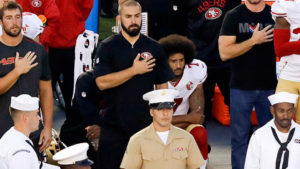 Amidst what he saw as a growing racial divide, in 2016, Colin Kaepernick made a fateful decision. After a successful college career, and several years as a back-up quarterback, he had finally been named starting quarterback for the San Francisco 49ers. He was on the cusp of a big-time professional career. Instead he took a sharp right turn and wound up challenging the whole country. True to James Baldwin’s maxim that part of being a real American is “insist [ing] on the right to criticize her perpetually,” he mounted a one-man challenge to the oppression and injustice he saw all around him. “I’ll continue to sit. I’m going to continue to stand with the people that are being oppressed … when there’s significant change and I feel like that flag represents what it’s supposed to represent, and this country is representing people the way that it’s supposed to, I’ll stand.”
Amidst what he saw as a growing racial divide, in 2016, Colin Kaepernick made a fateful decision. After a successful college career, and several years as a back-up quarterback, he had finally been named starting quarterback for the San Francisco 49ers. He was on the cusp of a big-time professional career. Instead he took a sharp right turn and wound up challenging the whole country. True to James Baldwin’s maxim that part of being a real American is “insist [ing] on the right to criticize her perpetually,” he mounted a one-man challenge to the oppression and injustice he saw all around him. “I’ll continue to sit. I’m going to continue to stand with the people that are being oppressed … when there’s significant change and I feel like that flag represents what it’s supposed to represent, and this country is representing people the way that it’s supposed to, I’ll stand.”
His was a vision of America that wasn’t about flag waving or anthem singing but about racial justice, opposition to police brutality, and to the economic and social oppression Americans of color experience every day of their lives. He made his case by kneeling in respectful silence when the anthem was sung. Did the American people celebrate his heroism? In light of surveys showing that 90% of Americans have an inherent racial bias for whites versus blacks, did his quiet, but forceful display of activism generate serious discussions about race and justice issues? A Seton Hall poll conducted after his protests went viral found that 56% of respondents objected to his actions. Another poll found that one-third of respondents gave his protest (now 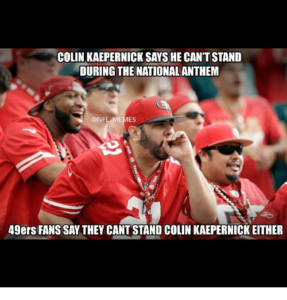 joined by a few other athletes) as their main reason for declining to watch NFL football games. In 2017, ratings for early season games continue to decline. President Trump considers it a victory for real Americans. Others consider it a commentary on football’s warts, like the widely-publicized risk that today’s football heroes may suffer dementia and early death tomorrow.
joined by a few other athletes) as their main reason for declining to watch NFL football games. In 2017, ratings for early season games continue to decline. President Trump considers it a victory for real Americans. Others consider it a commentary on football’s warts, like the widely-publicized risk that today’s football heroes may suffer dementia and early death tomorrow.
2017 has seen a growing revolt in some quarters against the Trump administration’s policies. This mass protest has been joined by players all over the league. Coaches and owners have stepped up to publicly support their activism. No NFL protestor is in danger of losing his job for participating.
Colin Kaepernick, whose solitary protest started the movement, hasn’t 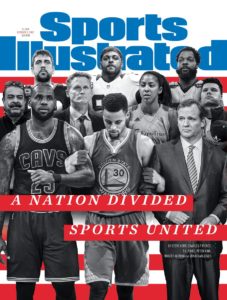 been so lucky. After voluntarily leaving the 49ers last spring, he has remained unsigned by any other team to this day. In a photo on the October 2nd Sports Illustrated cover, several athletes are shown linking arms (true to SI’s “play it safe” ethic, none are kneeling), Kaepernick is nowhere to be seen. SI’s lame excuse for the omission? “In some ways, even though his picture is not there, in some ways Colin Kaepernick is there, I think we all know that.” Translation: “Even though you can’t see him, he’s there. Trust us.”
been so lucky. After voluntarily leaving the 49ers last spring, he has remained unsigned by any other team to this day. In a photo on the October 2nd Sports Illustrated cover, several athletes are shown linking arms (true to SI’s “play it safe” ethic, none are kneeling), Kaepernick is nowhere to be seen. SI’s lame excuse for the omission? “In some ways, even though his picture is not there, in some ways Colin Kaepernick is there, I think we all know that.” Translation: “Even though you can’t see him, he’s there. Trust us.”
However, you look at the fate of Colin Kaepernick, fair or unfair, his decision to curse the darkness, to pit his strength of will against a corrupt and unforgiving system has started a movement where the competing moral visions of players and the president are on display. Social media have catapulted the issue to the front pages of newspapers and internet sites globally. Which side will the majority of the American public embrace? The athletes who by word and deed are signaling that social justice has become a moral imperative. Or Trump and his merry band of America First nationalists on the side of symbols, the flag, the national anthem as evidence of America’s “greatness.
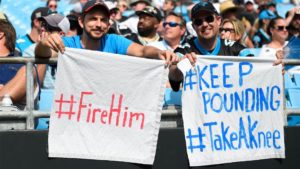 Neither side has yet won the battle for the hearts and minds of the American people. One thing for sure — for Colin and the NFL athletes who have joined the protest, action has replaced silence. Following in the footsteps of Dr. Martin Luther King, Jr. who had an equally painful choice—to remain silent or speak out against the Vietnam War. On April 4, 1967 (exactly one year to the day before his assassination) he denounced the war in his unforgettable “Beyond Vietnam” speech and predicted rightly that “[those] who break the silence of the night…have found that the calling to speak is often a vocation of agony…”
Neither side has yet won the battle for the hearts and minds of the American people. One thing for sure — for Colin and the NFL athletes who have joined the protest, action has replaced silence. Following in the footsteps of Dr. Martin Luther King, Jr. who had an equally painful choice—to remain silent or speak out against the Vietnam War. On April 4, 1967 (exactly one year to the day before his assassination) he denounced the war in his unforgettable “Beyond Vietnam” speech and predicted rightly that “[those] who break the silence of the night…have found that the calling to speak is often a vocation of agony…”
It is disheartening to realize that issues of social justice and racial equality that bedeviled Dr. King continue to haunt America. But we must also celebrate the few brave and lonely souls who recognize as he did that “A time comes when silence is betrayal.”
(For a different take on how the veneration of patriotic symbols often gets in the way of the debt we owe to the men and women who fight America’s wars, check out “Our Veterans Deserve Better Care than Old Glory”)

1,254 total views, 2 views today
